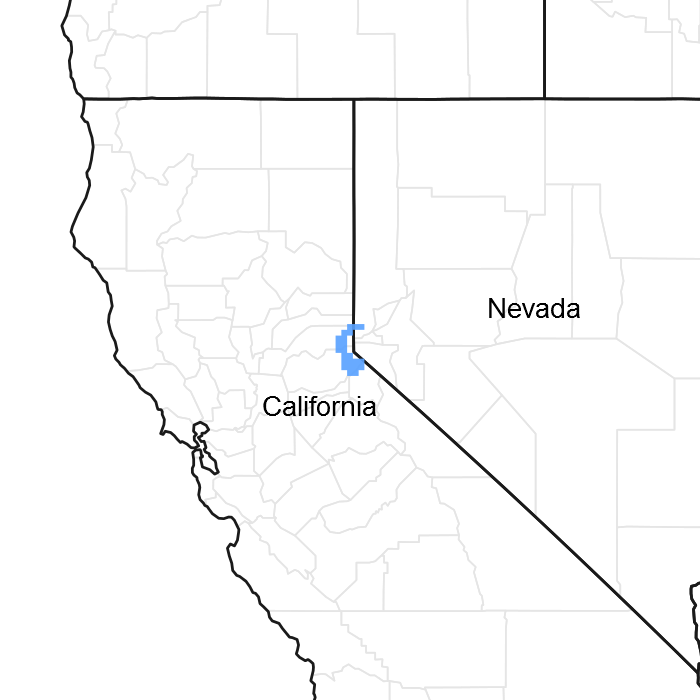

Natural Resources
Conservation Service
Ecological site R022AE213CA
Steep Rubbly Slope
Accessed: 12/22/2025
General information
Provisional. A provisional ecological site description has undergone quality control and quality assurance review. It contains a working state and transition model and enough information to identify the ecological site.

Figure 1. Mapped extent
Areas shown in blue indicate the maximum mapped extent of this ecological site. Other ecological sites likely occur within the highlighted areas. It is also possible for this ecological site to occur outside of highlighted areas if detailed soil survey has not been completed or recently updated.
MLRA notes
Major Land Resource Area (MLRA): 022A–Sierra Nevada and Tehachapi Mountains
MLRA 22A
Major Land Resource Area 22A, Sierra Nevada Mountains, is located predominantly in California and a small section of western Nevada. The area lies completely within the Sierra Nevada Section of the Cascade-Sierra Mountains Province. The Sierra Nevada range has a gentle western slope, and a very abrupt eastern slope. The Sierra Nevada consists of hilly to steep mountains and occasional flatter mountain valleys. Elevation ranges between 1,500 and 9,000 ft throughout most of the range, but peaks often exceed 12,000 ft. The highest point in the continental US occurs in this MLRA (Mount Whitney, 14,494 ft). Most of the Sierra Nevada is dominated by granitic rock of the Mesozoic age, known as the Sierra Nevada Batholith. The northern half is flanked on the west by a metamorphic belt, which consists of highly metamorphosed sedimentary and volcanic rocks. Additionally, glacial activity of the Pleistocene has played a major role in shaping Sierra Nevada features, including cirques, arêtes, and glacial deposits and moraines. Average annual precipitation ranges from 20 to 80 inches in most of the area, with increases along elevational and south-north gradients. Soil temperature regime ranges from mesic, frigid, and cryic. Due to the extreme elevational range found within this MLRA, Land Resource Units (LRUs) were designated to group the MLRA into similar land units.
LRU "E" Northern Sierran Upper Montane: This LRU occurs at the mid elevations of the Sierra Nevada, from the Sonora Pass area to the higher mountains in the vicinity of Quincy. Elevations are typically between 5,500 feet to 8,500 feet, with the lower elevations typically on southern aspects, and the higher elevations on northern aspects. The frost-free season is 60 to 125 days, MAAT ranges from 40 to 50 F, and MAP ranges from 35 to 85 inches. The soil temperature regime is mostly frigid, with some cryic soil temperatures at the upper elevations and northern aspects. Soil moisture regimes are mostly xeric, but may be udic where snow persists through spring.
Ecological site concept
This ecological site is found on steep, generally south-facing mountain slopes. Elevations are typically between 6,200 and 8,400 feet and slopes range from 30 to 90 percent. Soils developed on rocky talus fields, which have been deposited over dense glacial till or hard granitic bedrock. The dense till creates a root-restricting layer between 39 and 59 inches below the soil surface, while the bedrock occurs at depths of 7 to 20 inches. The reference plant community is montane chaparral, dominated by huckleberry oak (Quercus vaccinifolia), and greenleaf manzanita (Arctostaphylos patula) may be locally abundant. Trees, forbs and grasses are present at trace amounts. High solar radiation on warm south-facing slopes and the impermeable soil layer or shallow bedrock reduces the duration of moisture availability on this site, which restricts forest growth. Fire severity is high on these dry, south-facing slopes, and chaparral vegetation persists as a climax community due to a combination of poor abiotic suitability for forest growth and a positive feedback between flammable fire dependent vegetation and high severity fires.
Associated sites
| F022AC003CA |
Frigid-Cryic Sandy Slopes Occurs on higher elevation slopes with moderately to very deep sandy soils. Red fir (Abies magnifica) and western white pine (Pinus monticola) dominate the forest, with pinemat manzanita (Arctostaphylos nevadensis) dominant in canopy openings. |
|---|---|
| F022AC005CA |
Cryic Sheltered, Moist Sandy Mountain Slopes Occurs on adjacent north-facing slopes with deep sandy soils. A mixed-subalpine forest is present, with Sierra lodgepole pine (Pinus contorta var. murrayana), mountain hemlock (Tsuga mertensiana), red fir (Abies magnifica) and western white pine (Pinus monticola) all present. |
| F022AC007CA |
North-Facing Cryic Loamy Mountain Slopes Occurs on adjacent north-facing higher elevation slopes with moderately deep andic soils. A mixed conifer forest is present, with mountain hemlock (Tsuga mertensiana), red fir (Abies magnifica) and western white pine (Pinus monticola). |
| R022AC202CA |
Shallow Andesite Ridge Occurs on adjacent loamy shallow soils over andesitic bedrock. The vegetation is a low productivity shrubland dominated by low sagebrush (Artemisia arbuscula). |
| R022AC204CA |
Cryic, Umbric Or Andic Slopes Occurs on adjacent slopes with moderately to very deep, cryic with a thick umbric epipedon or andic properties. The vegetation is a productive shrubland dominated by mountain big sagebrush (Artemisia tridentata ssp. vaseyana) and antelope bitterbrush (Purshia tridentata). |
Similar sites
| R022AE217CA |
Frigid Volcanic Slopes This site occurs on shallow soils with loamy textures, and rock surface cover is not as high. Loamy soils support a higher diversity of shrubs and forbs. Production and cover are lower. |
|---|---|
| F022AF004CA |
Frigid, Shallow To Deep, Sandy Mountain Slopes This site occurs on shallow to moderately deep sandy soils on south-facing aspects, typically in a lower precipitation zone. Rock cover is not as high. This site supports and open Jeffrey pine (Pinus jeffreyi) forest, but disturbance phases have high shrub cover, and can resemble R022AE213CA. |
Table 1. Dominant plant species
| Tree |
Not specified |
|---|---|
| Shrub |
(1) Quercus vacciniifolia |
| Herbaceous |
(1) Eriogonum nudum |
Click on box and path labels to scroll to the respective text.

